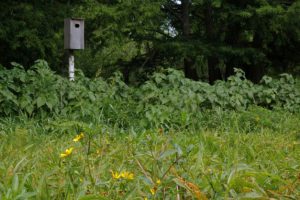Fall weather is on the horizon, which hopefully means we will all be spending some more time outside. Perhaps you’re already a bird watcher, but if not, this article might pique your interest. Did you know that we have 25 species of birds in Florida that require holes in trees for nesting sites? From woodpeckers to Carolina chickadees and even the massive turkey vultures, you may be providing homes for these birds in your yard without even knowing.
Cavity Nesters
How birds create their nest cavities depends on the species. Some, like woodpeckers, seek out dead or decaying wood to excavate…we call these primary cavity nesters. Others, like Eastern screech owls will take advantage of holes other birds have excavated, or find holes formed through disease, insects, lightning, etc. These birds are called secondary cavity nesters.
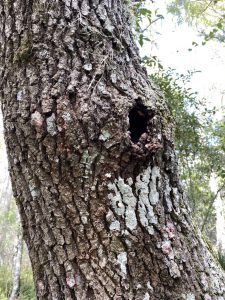
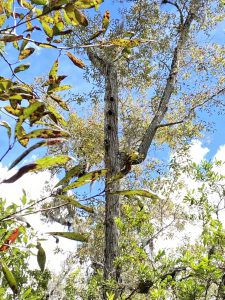
Much like us, birds need food, water, and shelter. Unfortunately for birds, their shelter is quickly being destroyed by our shelter. It’s safe to say that shelter is more of a limiting factor than food and water. Now, that doesn’t mean we shouldn’t also provide water sources and native plants to further support our feathered friends. I wrote a whole blog about tips for creating wildlife habitat a while back, so I won’t go into that now, but one of those tips also applies here: the importance of snags.
If you’re not up for building or buying a bird house, perhaps you would be okay to trim a dead or dying tree to remain standing as a snag. Snags are simply standing dead trees; they provide great potential for cavity nesters, and if nothing else, an amazing source of food for organisms big and small.
If you are up for building or purchasing a bird house, there are a couple things to keep in mind:
- One size does not fit all, and not all cavity nesters will use nest boxes. Woodpeckers for example aren’t as fond of our artificial nest boxes as the homes they create themselves. Others, like the Carolina wren will readily accept bird houses specifically built for them.
- Artificial nest boxes are typically only used during nesting season, not year-round. Some cavity nesters, like the Eastern screech owl, may continue to occupy the cavity as a roosting site throughout the year.
- If you build, they might not come. Just because you build, or purchase and install a bird house, does not mean birds will take up residence in them. Patience is key.
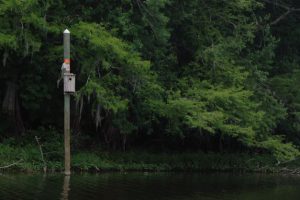
Things to Consider
To increase your chances of having a cavity nester take up residence in your bird house, it’s important to install it before nesting season (generally March-June), so usually installing by February is ideal. It’s also important to consider the following when purchasing or assembling bird houses:
- Attachment – How high and where the house is attached
- Cleaning – Hinged doors allow for easy maintenance
- Drainage – We don’t want rainwater sitting on the floor of the bird house, so ensure there are slits or holes to allow water to drain out
- Flooring – Ensuring the base of the bird house isn’t flush with the front, back and sides, helps prevent rainwater from seeping in from the bottom
- Screws/Nails– We have harsh weather in Florida, so at a minimum, galvanized screws and/or nails should be used, but there are many styles of nails available
- Paint – We might think painting bird houses is pretty, but birds prefer more natural, unpainted options
- Perches – These are not needed and actually not recommended for cavity nesters. Just as a natural cavity would not have a perch, homemade houses should not either as it only invites exotic birds like English sparrows and European starlings and provides better access for predators.
- Roof – Similar to the flooring, the roof should overhang the front to keep rainwater from dripping inside the house.
- Size – Size does matter. Remember, there are specific nest box plans for specific bird species. Be sure to do your homework before you build or install a nest box.
- Ventilation – Heat rises, and we have a lot of heat in Florida, so it’s important to provide slits or holes for ventilation at the top of bird houses, beneath the roof.
- Wood – Untreated wood is best to use for bird houses to prevent and possible exposure to toxins.
Don’t let this list overwhelm you; there are many resources available to guide you to building or purchasing the perfect bird house for the species you are hoping to support.
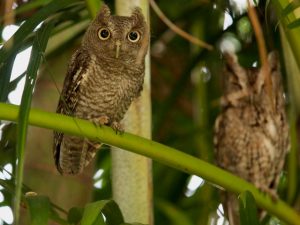
Common species you can attract in Pinellas County:
If you live in north Pinellas County, or areas surrounding Boyd Hill, Weedon Island Preserve, or other large natural areas, you may have luck attracting some less common resident species such as the Carolina chickadee, Eastern bluebird, and tufted titmouse. For a full list of cavity nesters in Florida, please visit: https://edis.ifas.ufl.edu/publication/UW058
Sources: https://edis.ifas.ufl.edu/publication/UW058 “A Birder’s Guide to Pinellas County (Florida)” by Ron Smith. https://www.fs.fed.us/psw/publications/watersj/waters3.PDF https://ufi.ca.uky.edu/treetalk/tree-cavities-for-the-birds https://nestwatch.org/learn/general-bird-nest-info/myths-about-nesting-birds/ https://projects.ncsu.edu/goingnative/howto/design/wildneed/nestboxtable.pdf
 0
0
